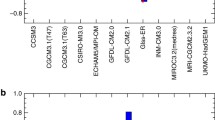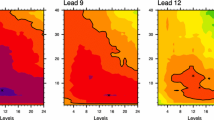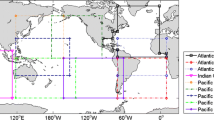Abstract
The recent hiatus in global temperature at the surface has been analysed by several studies, mainly using global climate models. The common accepted picture is that since the late 1990s, the increase in anthropogenic radiative forcings has been counterbalanced by other factors, e.g., a decrease in natural forcings, augmented ocean heat storage and negative phases of ocean–atmosphere-coupled oscillation patterns. Here, simple vector autoregressive models are used for forecasting the temperature hiatus in the period 2001–2014. This gives new insight into the problem of understanding the ocean contribution (in terms of heat uptake and atmosphere–ocean-coupled oscillations) to the appearance of this recent hiatus. In particular, considering data about the ocean heat content until a depth of 700 m and the Atlantic multidecadal oscillation is necessary for correctly forecasting the hiatus, so catching both trend and interannual variability. Our models also show that the ocean heat uptake is substantially driven by the natural component of the total radiative forcing at a decadal time scale, confining the importance of the anthropogenic influences to a longer range warming of the ocean.




Similar content being viewed by others
Notes
We are aware of a possible omitted variables bias in the results which aim to test the influence of RFNAT or RFANTH on OHC700. However, here we limit to 4-variate VARs because the “span” of our time series is quite short and, in this situation, the results of a 5-variate model could be unreliable due to the excessive number of coefficients to be estimated.
References
Allan RJ, Nicholls N, Jones PD, Butterworth IJ (1991) A further extension of the Tahiti-Darwin SOI, early SOI results and Darwin pressure. J Clim 4:743–749
Attanasio A, Pasini A, Triacca U (2012) A contribution to attribution of recent global warming by out-of-sample Granger causality analysis. Atmos Sci Lett 13:67–72
Bindoff NL, Stott PA, AchutaRao KM, Allen MR, Gillett N, Gutzler D, Hansingo K, Hegerl G, Hu Y, Jain S, Mokhov II, Overland J, Perlwitz J, Sebbari R, Zhang X (2013) Detection and attribution of climate change: from global to regional. In: Stocker TF, Qin D, Plattner G-K, Tignor M, Allen SK, Boschung J, Nauels A, Xia Y, Bex V, Midgley PM (eds) Climate change 2013: the physical science basis. Cambridge University Press, Cambridge, pp 867–952
Chen X, Tung K-K (2014) Varying planetary heat sink led to global-warming slowdown and acceleration. Science 345:897–903
Cowtan K, Way RG (2014) Coverage bias in the HadCRUT4 temperature series and its impact on recent temperature trends. Q J R Meteorol Soc 140:1935–1944
DelSole T, Tippett MK, Shukla J (2011) A significant component of unforced multidecadal variability in the recent acceleration of global warming. J Clim 24:909–926
Drijfhout SS, Blaker AT, Josey SA, Nurser AJG, Sinha B, Balmaseda MA (2014) Surface warming hiatus caused by increased heat uptake across multiple ocean basins. Geophys Res Lett 41:2077–2080
Enfield DB, Mestas-Nuñez AM, Trimble PJ (2001) The Atlantic multidecadal oscillation and its relationship to rainfall and river flows in the continental US. Geophys Res Lett 28:2077–2080
England MH, McGregor S, Spence P, Meehl GA, Timmermann A, Cai W, Gupta AS, McPhaden MJ, Purich A, Santoso A (2014) Recent intensification of wind-driven circulation in the Pacific and the ongoing warming hiatus. Nat Clim Chang 4:222–227
Goddard L (2014) Heat hide and seek. Nat Clim Chang 4:158–161
Granger CWJ (1969) Investigating causal relations by econometric models and cross-spectral methods. Econometrica 37:424–438
Guemas V, Doblas-Reyes FJ, Andreu-Burillo I, Asif M (2013) Retrospective prediction of the global warming slowdown in the past decade. Nat Clim Chang 3:649–653
Huber M, Knutti R (2014) Natural variability, radiative forcing and climate response in the recent hiatus reconciled. Nat Geosci 7:651–656
Karl TR, Arguez A, Huang B, Lawrimore JH, McMahon JR, Menne MJ, Peterson TC, Vose RS, Zhang H-M (2015) Possible artifacts of data biases in the recent global surface warming hiatus. Science 348:1469–1472
Können GP, Jones PD, Kaltofen MH, Allan RJ (1998) Pre-1866 extensions of the southern oscillation index using early Indonesian and Tahitian meteorological readings. J Clim 11:2325–2339
Kosaka Y, Xie S-P (2013) Recent global-warming hiatus tied to equatorial Pacific surface cooling. Nature 501:403–407
Levitus S, Antonov JI, Boyer TP, Baranova OK, Garcia HE, Locarnini RA, Mishonov AV, Reagan JR, Seidov D, Yarosh ES, Zweng MM (2012) World ocean heat content and thermosteric sea level change (0–2000 m), 1955–2010. Geophys Res Lett 39, L10603
Lütkepohl H (2005) New introduction to multiple time series analysis. Springer, New York
Macias D, Stips A, Garcia-Gorriz E (2014) Application of the singular spectrum analysis technique to study the recent hiatus on the global surface temperature record. PLoS ONE 9, e107222
McCabe GJ, Palecki MA (2006) Multidecadal climate variability of global lands and oceans. Int J Climatol 26:849–865
Meehl GA, Teng H, Arblaster JM (2014) Climate model simulations of the observed early-2000s hiatus of global warming. Nat Clim Chang 4:898–902
Morice CP, Kennedy JJ, Rayner NA, Jones PD (2012) Quantifying uncertainties in global and regional temperature change using an ensemble of observational estimates: the HadCRUT4 data set. J Geophys Res 117, D08101
Pasini A, Triacca U, Attanasio A (2012) Evidence of recent causal decoupling between solar radiation and global temperature. Environ Res Lett 7:034020
Pasini A, Triacca U, Attanasio A (2015) On the role of sulfates in recent global warming: a Granger causality analysis. Int J Clim. doi:10.1002/joc.4222
Ridley DA, Solomon S, Barnes JE, Burlakov VD, Deshler T, Dolgii SI, Herber AB, Nagai T, Neely RR III, Nevzorov AV, Ritter C, Sakai T, Santer BD, Sato M, Schmidt A, Uchino O, Vernier JP (2014) Total volcanic stratospheric aerosol optical depths and implications for global climate change. Geophys Res Lett 41:7763–7769
Ropelewski CF, Jones PD (1987) An extension of the Tahiti-Darwin southern oscillation index. Mon Weather Rev 115:2161–2165
Schmidt GA, Shindell DT, Tsigaridis K (2014) Reconciling warming trends. Nat Geosci 7:158–160
Sims CA (1980) Macroeconomics and Reality. Econometrica 48:1–48
Smith TM, Reynolds RW (2004) Improved extended reconstruction of SST (1854–1997). J Clim 17:2466–2477
Stern DI, Kaufmann RK (2014) Anthropogenic and natural causes of climate change. Clim Chang 122:257–269
Toda HY, Yamamoto T (1995) Statistical inference in vector autoregressions with possibly integrated processes. J Econ 66:225–250
Trenberth KE, Fasullo JT (2013) An apparent hiatus in global warming? Earth’s Future 1:19–32
Triacca U, Pasini A, Attanasio A, Giovannelli A, Lippi M (2014) Clarifying the roles of greenhouse gases and ENSO in recent global warming through their prediction performance. J Clim 27:7903–7910
Wiener N (1956) The theory of prediction. In: Beckenbach EF (ed) Modern mathematics for engineers vol 1. McGraw-Hill, New York, ch 8
Yao S-L, Huang G, Wu R-G, Qu X (2015) The global warming hiatus—a natural product of interactions of a secular warming trend and a multi-decadal oscillation. Theor Appl Climatol. published online, doi: 10.1007/s00704-014-1358-x
Zeng X, Beljaars A (2005) A prognostic scheme of sea surface skin temperature for modeling and data assimilation. Geophys Res Lett 32, L14605
Zeng X, Zhao M, Dickinson RE, He Y (1999) A multiyear hourly sea surface skin temperature data set derived from the TOGA TAO bulk temperature and wind speed over the tropical Pacific. J Geophys Res 104:1525–1536
Author information
Authors and Affiliations
Corresponding author
Rights and permissions
About this article
Cite this article
Pasini, A., Triacca, U. & Attanasio, A. Evidence for the role of the Atlantic multidecadal oscillation and the ocean heat uptake in hiatus prediction. Theor Appl Climatol 129, 873–880 (2017). https://doi.org/10.1007/s00704-016-1818-6
Received:
Accepted:
Published:
Issue Date:
DOI: https://doi.org/10.1007/s00704-016-1818-6




